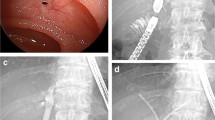Abstract
Introduction
Biliary duct injuries pose a significant management challenge due to the propensity for recurrent biliary strictures. Development of a modified Roux-en-Y hepaticojejunostomy known as a Hutson–Russell Pouch (HRP) provides a point of entry for repetitive access to the biliary tree. We aim to highlight the effectiveness of using the HRP as an access point for the long-term management of anastomotic and distal biliary strictures, thereby showcasing the value in potential widespread adoption of this modification to a standard surgical procedure.
Materials and methods
IRB-approved retrospective study of 36 patients (10 M, 26 F; mean age 55.19 ± 13.94; 15–83) underwent a total of 110 transjejunal cholangiograms. Indications for cholangiogram included cholangitis (n = 38), surveillance (n = 36), and elevated liver enzymes (n = 36). Technical success was defined by the ability to access and intervene in the biliary tree via HRP access. In case of stenosis, the ability to successfully dilate (< 30%) residual stenosis was considered a technically successful procedure. Clinical success was defined by normalization of the liver function tests or resolution of cholangitis.
Results
Technical success was achieved in 83/110 (75.45%) of the cases, and clinical success was achieved in 102/110 (98.2%). Transhepatic access was needed in 27/110 (24.5%) of the cases. Interventions performed included balloon cholangioplasty in 104/110 (94.5%), biliary stone removal in 2/110 (1.8%), biliary stent placement in 2/110 (1.8%), and biliary drain placement in 4/110 (3.6%). There were a total of 9/110 complications (8.2%).
Conclusion
The HRP was an effective access point in the management of recurrent benign biliary strictures in this cohort.



Similar content being viewed by others
References
Dimou FM, et al. Incidence of hepaticojejunostomy stricture after hepaticojejunostomy. Surgery. 2016;160(3):691–8.
AbdelRafee A, et al. Long-term follow-up of 120 patients after hepaticojejunostomy for treatment of post-cholecystectomy bile duct injuries: A retrospective cohort study. Int J Surg. 2015;18:205–10.
Goykhman Y, et al. Long-term outcome and risk factors of failure after bile duct injury repair. J Gastrointest Surg. 2008;12(8):1412–7.
Lillemoe KD, et al. Postoperative bile duct strictures: management and outcome in the 1990s. Ann Surg. 1990s;232(3):430–41.
Dickson ER, LaRusso NF, Wiesner RH. Primary sclerosing cholangitis. Hepatology. 1984;4(1 Suppl):33S–5S.
Kochhar G, et al. Biliary complications following liver transplantation. World J Gastroenterol. 2013;19(19):2841–6.
Hutson DG, et al. Balloon dilatation of biliary strictures through a choledochojejuno-cutaneous fistula. Ann Surg. 1984;199(6):637–47.
Russell E, et al. Dilatation of biliary strictures through a stomatized jejunal limb. Acta Radiol Diagn (Stockh). 1985;26(3):283–7.
Hutson DG, et al. Percutaneous dilatation of biliary strictures through the afferent limb of a modified Roux-en-Y choledochojejunostomy or hepaticojejunostomy. Am J Surg. 1998;175(2):108–13.
Judah JR, Draganov PV. Endoscopic therapy of benign biliary strictures. World J Gastroenterol. 2007;13(26):3531–9.
Venbrux AC, Osterman FA Jr. Percutaneous management of benign biliary strictures. Tech Vasc Interv Radiol. 2001;4(3):141–6.
Flum DR, et al. Bile duct injury during cholecystectomy and survival in medicare beneficiaries. JAMA. 2003;290(16):2168–73.
Walsh RM, et al. Long-term outcome of biliary reconstruction for bile duct injuries from laparoscopic cholecystectomies. Surgery. 2007;142(4):450–6.
Saad WE. Percutaneous management of postoperative anastomotic biliary strictures. Tech Vasc Interv Radiol. 2008;11(2):143–53.
Laasch HU, Martin DF. Management of benign biliary strictures. Cardiovasc Intervent Radiol. 2002;25(6):457–66.
Funding
This study was not supported by any funding.
Author information
Authors and Affiliations
Corresponding author
Ethics declarations
Conflict of interest
The authors declare they have no conflicts of interest.
Ethical Approval
This study has obtained IRB approval from the University of Miami/Jackson Memorial Hospital, and the need for informed consent was waived.
Informed Consent
Consent for publication was obtained for every individual person’s data included in this study.
Additional information
Publisher's Note
Springer Nature remains neutral with regard to jurisdictional claims in published maps and institutional affiliations.
Rights and permissions
About this article
Cite this article
Sandhu, J., Swersky, A., Salsamendi, J. et al. Utilization of a Modified Roux-en-Y Anastomosis as an Access point for Percutaneous Transjejunal Cholangioplasty of Recurrent Biliary Strictures. Cardiovasc Intervent Radiol 42, 1745–1750 (2019). https://doi.org/10.1007/s00270-019-02335-1
Received:
Accepted:
Published:
Issue Date:
DOI: https://doi.org/10.1007/s00270-019-02335-1




